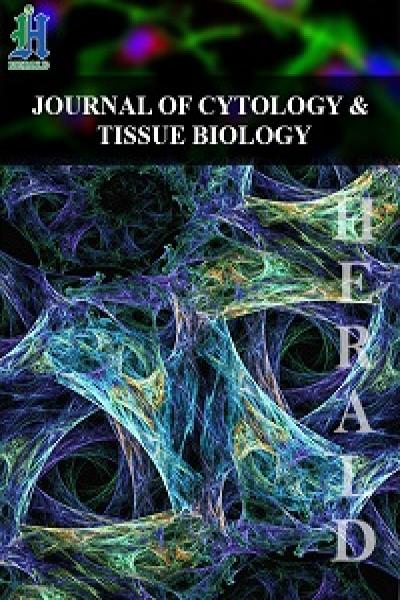
A Brief Introduction to an Altering Plant Characteristics Without Genetic Engineering
*Corresponding Author(s):
Bill CarringtonDepartment Of Cell Tissue Culture, BillBerry Farms Global Inc, California, United States
Tel: +1 616 215 8223,
Email:bbotanytc@gmail.com
Abstract
Background
New strains of plants can have improved properties and can provide useful resources. However, when new genes are introduced into plants by recombinant technology, the chromosomes of the resulting genetically modified plant cells can be altered in unpredictable and sometimes unfortunate ways. For example, introduced DNA can be inserted into essential genes and interrupt the function of such essential genes. New methods for generating new varieties of plants, for culturing new types of plant cells, and for extracting useful materials from such new plants and plant cells are needed.
Although new strains of plants have been made by protoplast fusion, the methods currently employed do not efficiently provide a high proportion of hybrid cells with desired characteristics. When such low efficiency methods are employed laborious cultivation of many plantlets may be needed, followed by extensive screening of the plantlets for selected trait (s) as well as for desirable functional agronomic characteristics before a suitable plant line can be identified.
Summary
This invention involves improved methods of generating hybrid plant cells and hybrid plants by somatic cell fusion without electric shock. The methods do not require recombinant alteration of cellular chromosomes by currently available genetic engineering procedures. For example, the inventive methods do not involve transformation of cells by insertion into plant chromosomes or transient expression of coding regions from expression cassettes, expression vectors, viral vectors, plasmids or other vectors commonly used for genetic engineering. Instead the nuclei of fused somatic cells can naturally exchange genetic information by homologous recombination using processes like those that occur naturally during sexual reproduction of plants. New types of hybrid cells are therefore formed that have desirable traits and improved characteristics.
Keywords
DETAILED DESCRIPTION
Although other researchers have performed protoplast fusions in the past, the procedures described herein not only improve the percentage of successful fusions but also yield more robust fusions that provide hybrid plant strains with useful new properties that are hardy and resistant to environmental stress.
PLANT MATERIAL
Types of fusions
- Rutaceae RUE or CITRUS FAMILY X Cannabis (Examples: lemon, lime, grape fruit, orange, mandarine, kumquat (Citrus), rue (Ruta), prickly-ash (Zanthoxylum))
- Rubiaceae COFFEE FAMILY X Cannabis (Examples: bedstraw, madder (Galium, Rubia), quinine tree (Cinchona), coffee (Coffea), yohimbine (Pausinystalia), buttonbush (Cephalanthus), West Indian jasmine (Ixora), morinda, noni (Morinda), pentas (Pentas), Ipecacuanha (Psychotria))
- Solanaceae TOMATO, PEPPER, POTATO &Lamiaceae FAMILY X Cannabis (Examples: potato/tomato (Solanum, incl. Lycopersicon), chili pepper/sweet pepper (Capsicum), basil, thai basil, sweet basil, angel trumpet (Brugmansia), tobacco (Nicotiana), petunia (Petunia), tomatillo (Physalis), jimsonweed (Datura), saint joseph’s wort)
- Cannabaceae family all types and species can undergo protoplast fusion with any other Cannabaceae family members, including any other type or species of Cannabaeae (Examples: Sativa hybrid, Indica hybrid, Sativa, Indica, hemp hybrid)
RESULTS
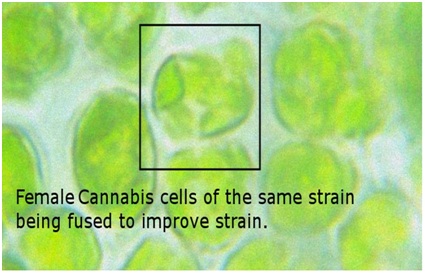
Figure 2 graphically illustrates the THC content of Sativa and Indica control plant seeds that have not been generated from hybrid cells as described in this Example (left-most bars), compared to Sativa and Indica hybrid plant somatic synthetic seeds enerated from hybrid cells as described in this Example (right-most bars). The middle bars in figure 1 show the THC content of Sativa and Indica tissue culture plantlets.
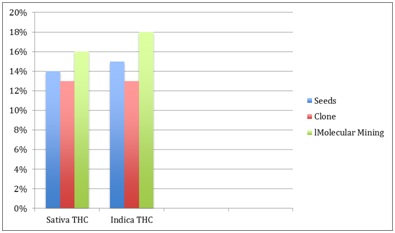 Figure 2: Shows graphically illustrates the THC content of Sativa and Indica control plant seeds that have not been generated from hybrid cells as described in this Example (left-most bars), compared to Sativa and Indica hybrid plant somatic synthetic seeds generated from hybrid cells as described in this Example (right-most bars). The middle bars in figure 1 show the THC content of Sativa and Indica tissue culture plantlets.
Figure 2: Shows graphically illustrates the THC content of Sativa and Indica control plant seeds that have not been generated from hybrid cells as described in this Example (left-most bars), compared to Sativa and Indica hybrid plant somatic synthetic seeds generated from hybrid cells as described in this Example (right-most bars). The middle bars in figure 1 show the THC content of Sativa and Indica tissue culture plantlets.EXAMPLE 5: FUSION OF BASIL AND CANNABIS PROTOPLASTS
The materials described in Example 1 and the methods described in Examples 2 and 3 were utilized to generate an interspecies hybrid between basil cells and cannabis cells.Protoplast fusions are readily spotted by their appearance of an overly large polykaryon (multi-nuclear protoplast or cell). Use of cell with two different sizednuclei or two differently sized cells facilitates identification of fusions. In addition, infiltration or injection of cellular dyes into one cell type also makes it easier to see fusion of the cannabis and basil protoplasts.
Figure 3 shows a blue-dyed basil cell fused with a cannabis cell. As illustrated, the hybrid cell is enclosed by a cellular membrane.
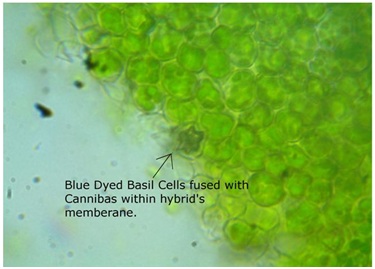
Figure 4 shows another fusion between a blue-dyed basil cell and a cannabis cell.
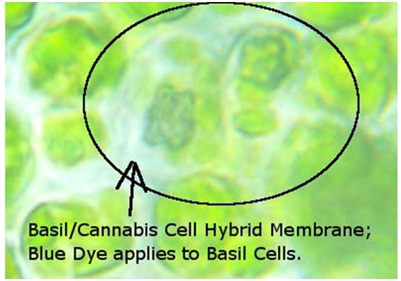
All patents and publications referenced or mentioned herein are indicative of the levels of skill of those skilled in the art to which the invention pertains, and each such referenced patent or publication is hereby specifically incorporated by reference to the same extent as if it had been incorporated by reference in its entirety individually or set forth herein in its entirety. Applicants reserve the right to physically incorporate into this specification any and all materials and information from any such cited patents or publications.
CONCLUSION
The following statements of the invention are intended to describe and summarize various embodiments of the invention according to the foregoing description in the specification.
REFERENCES
Citation: Carrington B, George M (2019) A Brief Introduction to an Altering Plant Characteristics Without Genetic Engineering. J Cytol Tissue Biol 6: 023.
Copyright: © 2019 Bill Carrington, et al. This is an open-access article distributed under the terms of the Creative Commons Attribution License, which permits unrestricted use, distribution, and reproduction in any medium, provided the original author and source are credited.
